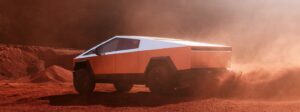Since Elon Musk unveiled the concept vehicle in 2019, Tesla enthusiasts have been clamoring for the Cybertruck. The futuristic, stainless-steel clad, electric vehicle was met with such anticipation that nearly two million reservations were made by November 2023. Each order required a $250 deposit!

Tesla Cybertruck Photo credit: Tesla.com
The first batch of Cybertrucks were delivered to excited customers just in time for Christmas of 2023. However, by April 17, 2024, the National Highway Traffic Safety Administration (NHTSA), a supervising agency within the U.S. Department of Transportation, delivered a major announcement. Tesla had to implement a recall for all 3,878 Cybertrucks sold as of that date to fix an accelerator pedal pad that could come loose and get lodged in the interior trim. This issue could cause the Cybertrucks to unintentionally accelerate. Unlike most Tesla recalls, this one cannot be fixed with a simple downloaded software update. Tesla will have to have owners respond to letters and bring the Cybertrucks into its service centers for a repair at no charge.
The two types of auto recalls
Vehicle recalls are a frequent occurrence in the automotive industry. They mainly fall into two categories: safety recalls and non-safety recalls. Safety recalls are initiated by the manufacturer or by the NHTSA if a safety issue is identified that could increase the risk of a crash or injury. The most common safety recalls typically involve defective airbags, seat belts, and tires.
Non-safety recalls are far more uncommon and are issued to address problems that could affect the performance or durability of the vehicle. Think of issues like poor paint jobs or parts that corrode quickly. Although these issues may not be hazardous, they are still significant to owners because they adversely affect the overall reliability and functionality (not to mention resale value) of a vehicle.
Federal regulations require manufacturers to communicate with vehicle owners and repair or replace the parts without charging the customer. In some rare instances, the manufacturer even offers a refund or repurchases the vehicle back from the buyer. However, automakers may not be so generous with non-safety recalls – typically, they simply lengthen manufacturer warranties for an additional period of time. The problem with this, is that owners are stuck with a repair bill if they discover the recall after the warranty expires.
What happens if the recall notice is sent to my previous address?
Although manufacturers have a mandate to promptly notify owners of recalls, the means of communication may not reach the party at risk. What if the automaker sends a letter to the owner’s last known address but the owner no longer resides there?
To ensure that owners have a way of staying abreast of all relevant recalls, the NHTSA website includes a helpful search engine. If the owner inputs their state license plate number, VIN number or the year, make and model of the vehicle, they will receive information regarding the number of issued recalls, as well as all manufacturer communications pertaining to those recalls.
Can I drive my car while waiting for my recall service appointment?
It is of the utmost importance that owners stay aware of recalls because the notices specify whether it’s safe to continue driving the vehicle while it waits to be serviced. For example, in 2022, Mercedes-Benz recalled more than 292,000 SUVs because of a potential problem with the brakes. Owners of vehicles included in the massive recall were informed that they should not drive them until a free recall repair was performed.
This major recall, combined with the highly-publicized Tesla Cybertruck recall, has revived an interesting question: What happens if a defect that is the subject of an auto recall causes a driver to have a dangerous accident?
Auto recalls and car accidents
If a malfunctioning part or design error leads to an accident that causes injuries, product liability law may hold manufacturers responsible for those injuries. To win a product liability case, a plaintiff (injured party) must prove three elements:
- Defect: The product must have a defect that makes it unreasonably dangerous for its intended use. Defects can be in design, manufacturing, or failure to warn.
- Causation: The defect must have been the proximate cause of the plaintiff’s injury. This means the defect must have been a substantial factor in bringing about the harm.
- Strict Liability: Product liability laws can vary by state. In some states, manufacturers are held strictly liable, meaning they are responsible for the defect regardless of negligence (carelessness).
A product recall can be a double-edged sword for product liability cases, because it serves as strong evidence that the manufacturer was aware of a potential defect in the product. Courts often allow recall information to be presented as evidence to support the plaintiff’s claim that the product was defective. The severity of the recall can also influence the case. A safety recall indicating a high risk of injury can strengthen a plaintiff’s position.
How car manufacturers attempt to avoid liability in lawsuits
It should be noted that a recall is not an automatic admission of fault by the manufacturer, as they argue that they often recall products out of an abundance of caution to minimize potential harm. In order to protect themselves from issues of liability, the manufacturer’s recall notice itself may not specify the exact nature of the defect, making it harder for the plaintiff to prove their case.
Even with a recall, the burden of proof still lies with the plaintiff to demonstrate the specific defect in their vehicle that caused their injury. Plaintiffs also must show that the defect existed at the time they purchased the vehicle.
Even if the defect was present when the plaintiff bought the vehicle, the manufacturer, who is usually very well-represented, will rely on the following arguments to avoid liability:
- The plaintiff misused the vehicle.
- The defect was not present at the time of purchase (e.g., caused by aftermarket modification).
- The plaintiff was aware of the recall and continued to use the vehicle, assuming the risk.
Why legal representation is vital
Navigating the complexities of product liability law, especially with a new and potentially complex vehicle like the Cybertruck, requires legal expertise. A lawyer can help gather evidence, understand the recall details, and build a strong case against the manufacturer.
Auto recalls are a crucial safety measure, but their impact on product liability cases is nuanced. While a recall can be valuable evidence, it’s not a guaranteed win for the plaintiff. Understanding the legal framework and the specific details of the recall and the alleged defect are vital for both the injured party and the manufacturer.
The attorneys at Allen & Allen are here to use their knowledge of the law and experience to protect all who are injured due to the negligence of others. If you have been injured due to a defective auto part or design flaw, you may be entitled to compensation. For a free case evaluation, call us today, at 866-308-1307.


